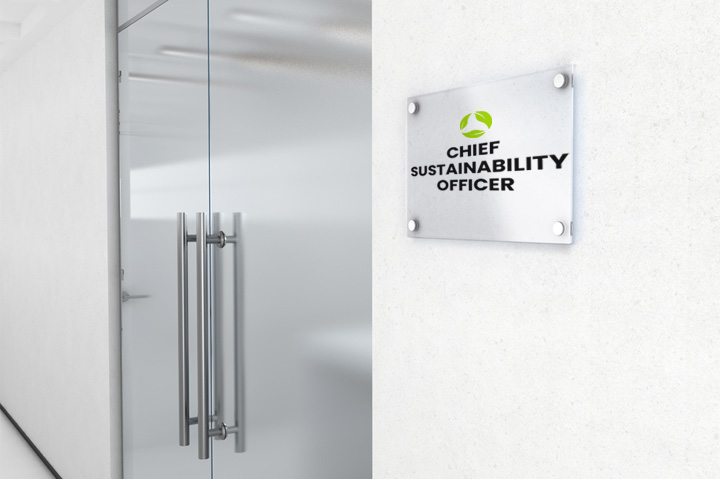Sustainability October 04, 2022
Do You Need a Chief Sustainability Officer?
Amid rising demand for sustainability and increased environmental regulation, CSOs are a growing phenomenon.
Back in 2011, recruitment firm the Weinreb Group started tracking the number of chief sustainability officers at publicly traded companies. At the time, they had just 29 names on their list.
A decade later, that number was up 228%, according to the latest report from the firm.

And the number of CSOs continues to grow – so quickly, in fact, that the Weinreb Group has stopped counting. “CSOs were getting named weekly,” says Ellen Weinreb, founder of the recruitment firm. “It was hard to put the pen down and say as of this date, these are the numbers of CSOs.”
Other reports jibe with Weinreb’s findings. Companies appointed about as many CSOs in 2020-21 as in the previous eight years combined, according to a study by PwC, which also noted that about 30% of the 1,640 firms it looked at had a CSO and another 50% had a sustainability executive with more limited power.
So, what’s behind the rapid growth of this relatively new C-suite position? A lot of it – at least in large publicly traded companies – is being driven by the investor sector, which is increasingly requiring corporations to measure and meet environmental, social and governance (ESG) targets, according to Weinreb.
And there are simply too many moving parts – whether it’s setting science-based emission-reduction targets or meeting ethical labor standards – not to have a full-time leader focused on sustainability and social responsibility, says Chris Fox, CSO of HanesBrands (asi/59528).
“Environmental, social and governance issues have broadened, and I think, quite frankly, just gotten more complex,” Fox says. “Having one person that pulls that all together in an organization, especially a bigger organization, really is important. It’s really difficult to kind of piecemeal these issues with part-time roles.”
Though the idea of a promotional products CSO isn’t commonplace yet, the tide is starting to turn, and it might be wise to put formal leadership in place to focus on the growing field of sustainable business.
“For major players on the supplier side and if you’re a large Top 40, you probably want to start thinking about having sustainability people on your team,” says Denise Taschereau, CEO and co-founder of distributor Fairware (asi/191452), a Vancouver-based B Corp that focuses on ethical sourcing of sustainable products.

Sustainability Staffing at Smaller Companies
Chief sustainability officers have an obvious seat at the table in organizations that already have an established C-suite. But what about at smaller firms that don’t have a slate of executives on staff? How can they meet the increasing demand from clients for a transparent and sustainable supply chain? How do they measure their own environmental impact and develop energy reduction goals without having employees dedicated specifically to those areas? Here are three possibilities, along with the pros and cons for each.
1
Create a committee
Pro: Putting together a so-called “green team” – a small group of employees dedicated to finding more sustainable solutions throughout the company – can be a good way for companies to get their feet wet. “If you don’t have the resources to hire someone with experience, you could start a committee of people who have an interest in sustainability,” says Megan Spire, vice president of sales at Bella + Canvas (asi/39590). “You could build up from there.”
Con: While “green teams” are good at “low-hanging fruit” like setting up office composting or other internal programs, many such groups don’t have accountability or authority and thus don’t get anything substantive accomplished, says Denise Taschereau, CEO and co-founder of Fairware (asi/191452). “It can be effective, but you have to empower them,” she adds. “Otherwise, it’s just kind of like people having lunch four times a year.”
2
Bake sustainability into every employee’s job description
Pro: Though sustainability is integral to Fairware’s operations – “This is our jam,” Taschereau says – none of the distributor’s 20-plus employees is dedicated full time to sustainability. Instead, environmental considerations are embedded into each role. For example, Fairware’s shipping expert took the lead on managing carbon offsets. Sales reps are accountable for learning about the various sustainable products they’re selling. “We all have a partial accountability,” she says. “That’s the play for small and mid-size folks.”
Con: Distributing sustainability-related tasks among staffers can lead to confusion and redundancy. “If you try and scatter it too much in various functions and give this person 10% of a responsibility, the next person 20% and they’re never talking to each other, that doesn’t work,” says Chris Fox, CSO of HanesBrands (asi/59528).
3
Hire a consulting firm
Pro: Sustainability consultants can do things like perform a lifecycle analysis on your products, or help a company measure its carbon footprint and create benchmarks to reduce energy and water usage over time. Having a third party with a fresh set of eyes evaluate the way things have always been done could be key in identifying inefficiencies and waste in your processes.
Con: A third-party evaluation could be time-consuming and costly, and if the company as a whole doesn’t take the recommendations to heart and make changes, that investment would have gone to waste.
In the past, the promo industry did a great job of getting ahead of product safety legislation, she adds. “I think that’s a good roadmap for the industry,” she adds.
Future legislation surrounding climate, labor and other sustainability-related issues is likely to be “more patchwork, complex and nuanced” than laws surrounding product safety, Taschereau says, but that’s all the more reason to get a head start now.
“Get the mindset that this is a big thorny issue coming down the pipeline,” she says, and “use some of the muscles developed” in the product safety process to tackle this new area.
In the U.S. thus far, sustainability and corporate social responsibility have largely been voluntary efforts, Fox notes, adding that over the next three to five years, however, “This is going to be a much more regulated space.”
“A lot of folks who haven’t focused on [sustainability] as much in the last five years in particular, they’re going to wake up to a shocking set of requirements that they’re going to have to scramble to be able to meet, and I don’t think we’re going to be in that same position,” says Fox, who has been involved in ESG efforts at Hanes for at least 15 of the 23 years he’s worked for the apparel maker.
What Do CSOs Do?
Sustainability and social responsibility, in many ways, were baked into fashion forward apparel supplier Bella + Canvas (asi/39590) from day one – since it launched back in the late 1990s. The company uses seven times less water than the average clothing manufacturer, has taken a number of steps to reduce carbon emissions and it sends almost nothing to landfills, according to its website. The supplier repurposes excess fabric into things like baby bibs or upholstery stuffing and has a robust recycling program. It wasn’t until a couple of years ago, however, that Bella hired a staffer dedicated specifically to sustainability and social compliance.
“It had just gotten to a point where we needed someone at the helm in the day to day,” says Megan Spire, vice president of sales at Bella + Canvas.
In particular, the supplier needed a steady hand to guide it through the process of joining the Fair Labor Association (FLA), committing to creating safe and humane working conditions throughout its supply chain and working to improve conditions through sustainable solutions. Bella has 1.2 million square feet of operations in Los Angeles, a 500,000-square-foot operation in Alabama, plus factories in South and Central America – all of which must be audited to ensure that “everything that we do, no matter where we are in the world, adheres to not only our standards, but meets FLA’s requirements as well,” Spire explains. That’s why, she adds, the director of social compliance position was created.
“You have to have buy-in from the top to be effective. If you don’t have that you’re going to be pushing a rock up the hill.”Chris Fox, HanesBrands
Over at HanesBrands, the CSO position has evolved over the years. Fox, a lawyer by training, focused heavily on labor and factory compliance issues when he started out with the apparel manufacturer. “That’s where I really cut my teeth,” he says. “This industry was more on the social and governance side of ESG, rather than the environmental.”
In recent years, though, environmental issues have gained more prominence. HanesBrands has created a set of ambitious sustainability goals to reach by 2030, including a 50% reduction in Scope 1 and 2 emissions and a 30% reduction in Scope 3 emissions. The manufacturer is also working toward a 25% reduction in energy use in its owned facilities and a 25% reduction in water use in its owned operations. Plus, the company hopes to reach 100% renewable electricity in its owned operations through direct investment and renewable energy credits, according to its website.
Earlier this year, HanesBrands reported that it had reduced Scope 1 and 2 emissions by 11% and that it’s generating 48% of its electricity from renewables. The supplier also reduced usage of single-use plastics by 15% compared to a 2019 baseline standard, while also cutting packaging weight by 5%.
“We have literally saved hundreds of millions of dollars in energy costs over the years with a really heavy focus on using less and transitioning to renewables,” Fox says. “We’ve identified probably between $7 million and $10 million in packaging savings this year just by focusing on it from a cost perspective.”
Kris Robinson, CSO of Top 40 supplier PromoShop (asi/300446) and a member of the Promo for the Planet advisory board, started ecopromos.com back in 2007. Robinson says PromoShop was the first ASI distributor “that had anything that focused just on green sustainable products and all that stuff.”
In addition to raising awareness about eco-friendly practices within his own company, Robinson has tried to educate the rest of the industry on the benefits of sustainability, calling on suppliers at the time to stop producing so many print catalogs and switch to Forest Stewardship Council (FSC) certified paper when printing was necessary.
And even though the industry has made notable strides with sustainability, to Robinson’s knowledge, chief sustainability officers remain a rarity among distributors.
Figurehead or Agent of Change?
Once a sustainability professional has been appointed at a company, it’s not necessarily a given that big operational and structural changes will follow. PwC’s study on the rise of CSOs found that “a significant number of companies have CSOs whose sustainability mandate is limited, based on their role or overall standing in the corporate hierarchy.” These so-called “CSO light” executives “lack the influence to shape the sustainability transformation.”
Indeed, simply appointing a CSO is not enough, without cooperation from the entire organization. “You have to have buy-in from the top to be effective,” Fox says. “If you don’t have that you’re going to be pushing a rock up the hill.”
228%
The growth rate of chief sustainability officers at publicly traded companies from 2011 to 2021.
(The Weinreb Group)
One method to get there is simply through passionate evangelizing: “I always say: Lead by example,” Robinson says. “I’m constantly teaching our people, trying to push them [toward eco-friendly options]. … The majority of our industry are order-takers; they’re just out there pushing product, but if you use consultative selling and make clients aware that there’s other materials out there that are better for the environment and still get your message across, it makes a difference.”
Companies that are not only transparent about but actively promote their sustainability progress to the public are likely to attract talent who want to be a part of it, Spire says, which helps CSOs and other dedicated sustainability staff meet their mandate. “They want to align themselves and what they do with a company of similar ethos,” she adds.
It’s also important that every department understands and has a chance to contribute. The marketing department needs to be well-versed in the company’s sustainability efforts to effectively communicate them to the public, for example. And employees in logistics are the ones in the weeds of packaging and shipping, so they need a voice when it comes to things like carbon emissions and recycling efforts, Spire says. “You have to have departments involved in the strategy build that are actually responsible for performance in those areas,” she adds.
If the altruistic reasons for focusing on sustainability aren’t enough of a motivator, money talks. “One way to convince your senior team to get on board is that they can save a bunch of money by focusing on these issues,” Fox says. “Hook them on the notion that this will have a direct and immediate positive impact on your business and your financials.”

Promo for the Planet is your destination for the latest news, biggest trends and best ideas to help build a more sustainable and socially-responsible industry.
